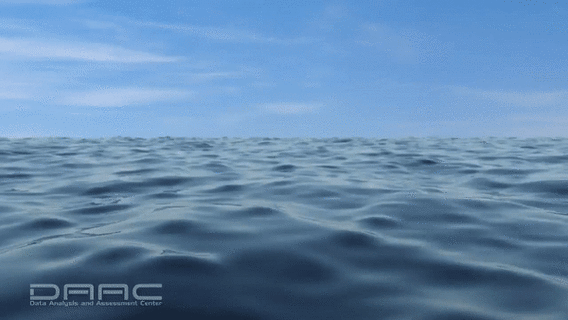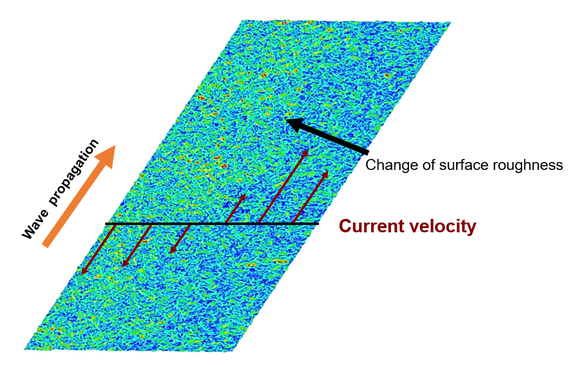Water wave field is a complex nonlinear dynamic system. For its accurate simulation, we have developed a suite of high-fidelity simulation tools. The first method we employ is the high-order spectral (HOS) method. It is based on the potential flow theory using the Zakharov formulation and perturbation expansion with respect to the mean water surface to high order of nonlinearity. It is highly accurate with an exponential convergence rate with respect to the number of wave modes. It is also highly efficient with the computational cost only linearly proportional to the order of wave nonlinearity. Recently, we have implemented physics-based models for wind input and wave dissipation in our HOS code (for the direct simulations of wind forcing and wave breaking, please check the wind-wave interaction section). It has also been extended to sub-sea bathymetry variation and internal waves.
While the HOS method is based on irrotational flow theory, we have also developed a method for the simulation of surface wave motions in the presence of shear currents. Ocean currents can lead to complex vortical motions. When we consider the effects of shear currents, the water motions are no longer irrotational. We use a boundary integral method to set up the velocity equations of surface waves. Perturbation of the integral kernel combined with Fast Fourier transform makes three-dimensional simulation efficient. This model lifts the constraint of the potential flow assumption and is able to accurately and efficiently simulate nonlinear wave interaction in the presence of complex currents. The figure below shows an example of our simulation results. The current field is obtained from our LES of a cold front filament. The variation of surface wave roughness across the front, which has often been observed in field, is captured dynamically in our simulation.
A salient feature of our wave field simulations is that the wave phases are explicitly resolved, in contrast to the conventional phase-averaged wave models.
In the presence of breaking waves, the simulations are performed on Eulerian grid and we solve the air and water as a coherent system. The interface between air and water is tracked by the coupled level-set and volume-of-fluid (CLSVOF) approach, wherein the level-set method captures the geometry of air-water interface accurately, while the volume-of-fluid method conserves the mass of each phase of the fluids precisely. The density and viscosity are determined based on the fluid phase. Using the above approach, we are able to simulate realistic and complex ocean wave field for a wide range of applications with unprecedented high resolution and accuracy.
Selected Publications:
- Wu, J., Hao, X., Li, T. & Shen, L. (2023), “Adjoint-based high-order spectral method of wave simulation for coastal bathymetry reconstruction,” Journal of Fluid Mechanics, accepted.
- Yue, L., Hao, X., Shen, L. & Fringer, O. (2023), “Direct simulation of the surface manifestation of internal gravity waves with a wave-current interaction model,” Journal of Physical Oceanography, Vol. 53, 981-993.
- Hao, X., Wu, J., Rogers, J., Fringer, O. & Shen, L. (2022), “A high-order spectral method for effective simulation of surface waves interacting with an internal wave of large amplitude,” Ocean Modelling, Vol. 173, 101996.
- Hao, X. & Shen, L. (2020), “Direct simulation of surface roughness signature of internal wave with deterministic energy-conservative model,” Journal of Fluid Mechanics, Vol. 891, R3.
- Wu, J., Hao, X. & Shen, L. (2022) “An improved adjoint-based ocean wave reconstruction and prediction method,” Flow, Vol. 2, E2.
- Wu, J., Ortiz-Suslow, D., Hao, X., Wang, Q. & Shen, L. (2022), “A model sensitivity study of ocean surface wave modulation induced by internal waves,” Earth and Space Science, Vol. 9, e2022EA002394.
- Li, T. & Shen, L. (2020), “Safe zone for phase-resolved simulation of interactions between waves and vertically sheared currents,” Applied Mathematics Letters, Vol. 104, 106272.
- Li, T., Xuan, A. & Shen, L. (2020), “Study of nonlinear interaction between waves and ocean currents using high-fidelity simulation and machine learning,” 33rd Symposium on Naval Hydrodynamics.
- Yang, Z., Deng, B. & Shen L. (2018), “Direct numerical simulation of wind turbulence over breaking waves,” Journal of Fluid Mechanics, Vol. 850, pp.120-155.



